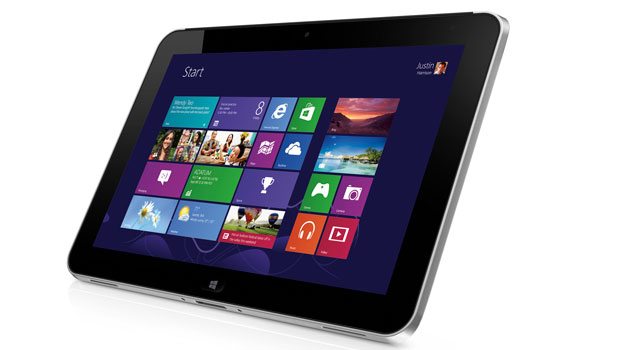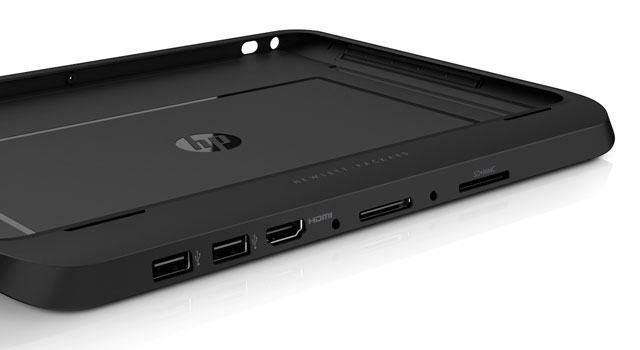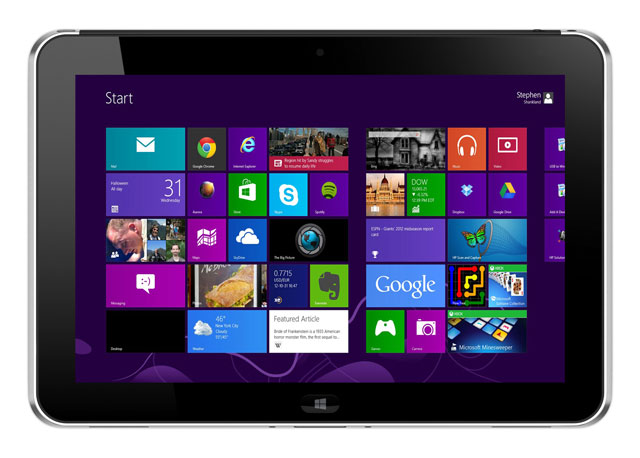
Tablet computers running full versions of Windows 8 were, at least according to Microsoft, meant to provide the portable computing power business users demand. Unfortunately, Hewlett-Packard’s Elitepad 900 fails to live up to that promise because of a lack of processing clout, a hefty price tag and the need for “optional accessories” if you want USB ports, a card reader or an HDMI port.
The ElitePad 900’s aluminium-clad rear, Corning Gorilla Glass screen and physical buttons all suggest it’s a premium device. Any doubts about its positioning at the top-end of the market are removed by its eye-watering local price tag of R11 999. And then you’re going to have to fork out a little more to get the full functionality of this 10-inch tablet.
Aside from a poor proprietary connector in the middle of the bottom of the tablet, the only ports on the ElitePad 900 are the Sim and microSD slots hidden beneath an aluminium panel on the right-hand side. An adaptor that converts the proprietary connection into a USB port is included, but it’s baffling why HP took this route rather than simply building a dedicated USB port on the tablet itself as Microsoft has done with its Surface range.
In order to rectify this shortcoming, HP has released a range of “smart jackets” — cases that include two USB ports, an HDMI port and a MMC/SD card reader slot. As pleasing as the added ports are, not only do the jackets make the tablet larger, they necessitate forking out even more money — at least another grand.

For something that’s meant to be a dedicated, top-end business tool, the ElitePad 900 could have done with a little more time on the drawing board.
If you don’t demand much of its 1,8GHz Atom processor, the ElitePad 900 is great. Performance is speedy, despite the “Windows Experience rating” of just 3.3, and it’s certainly novel having the full Windows 8 Pro — complete with a full desktop — on a tablet. The problem is with its crummy specifications and limited on-board storage (32GB, of which 25GB is usable), any hopes of running processor intensive applications or replacing one’s laptop with the ElitePad are misplaced.
On the core specifications front, the ElitePad 900 fares tolerably well against the competition. The 8-megapixel rear-facing camera and 1080p front-facing one are excellent, the 1 280×800-pixel resolution display is bright — albeit lower resolution than we’ve been conditioned to expect from contemporary slates — and the stereo speakers on the bottom of the device make for better sound than the single speakers many rivals opt for.
On paper, the HP ElitePad 900 isn’t intended to compete with Apple’s iPad or Samsung’s Galaxy Tab 10.1 but rather to fill the enterprise-shaped gap in the market HP is suggesting exists.
The argument goes something like this: only a Windows 8-powered tablet can run the sort of software used in the modern workplace and properly mimic the desktop experience.

There are two flaws in this line of reasoning. The first is that the ElitePad 900 doesn’t have the processing power to handle full-blown desktop applications anyway, and the second is business users on iPads and Android tablets seem to get by quite happily.
There’s no doubt Windows-powered tablet computers will continue improving, and there will be those for whom the option to run Microsoft Excel is an imperative, but the only people we can envision using the ElitePad 900 are those upon whom it is foisted.
Why anyone would buy the HP ElitePad 900 instead of a laptop is beyond us, particularly given the additional outlay on accessories required to make an already costly device a meaningfully useful one. And for those wanting a tablet with USB ports, there are plenty of alternatives. — (c) 2013 NewsCentral Media




